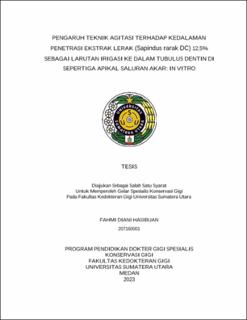| dc.description.abstract | Root canal cleaning and shaping is an important step in endodontic therapy. lerak
extract is a natural irrigation solution. Bacteria can penetrate up to around 300-500 μm
into the dentin tubules. These bacteria have the potential to cause Treatment failure,
therefore, deep penetration of the irrigating agent into the dentinal tubules is highly
desirable. The aim of this study was to determine the effect of sonic and ultrasonic
agitation techniques on the penetration of irrigation solutions of 12.5% lerak extract, 3%
NaOCl + 12.5% lerak extract and 3% NaOCl + 17% EDTA into the dentinal tubules in
the apical third of the root canal.
Thirty-six single-root mandibular premolars were decoronated at the
Cementoenamel Junction (CEJ) level. Root canals were prepared with the S-One Blue
#35.06 rotary file system. Teeth were divided into 6 groups, namely IA (12.5% lerak
extract irrigation group + sonic agitation), IB (12.5% lerak extract irrigation group +
ultrasonic agitation), IIA (3% NaOCL irrigation group + 12.5% lerak extract % + sonic
agitation), IIB (NaOCl irrigation group 3% + lerak extract 12.5% + ultrasonic agitation,
IIIA (irrigation group NaOCL 3% + EDTA 17% + sonic agitation), IIIB (irrigation group
NaOCL 3% + EDTA 17 % + ultrasonic agitation). Dentin tubules were stained by
irrigating the root canal with irrigation solution mixed with rhodamine b powder then
agitated. All teeth were cut 4 mm from the apex, examined with CLSM (Confocal Laser
Scanning Microscopy).The data obtained was subjected to a One-way ANOVA statistical
test and continued with a Post Hoc test.
The results of the One-way ANOVA test showed a significant difference (p<0.05)
in the penetration of the 12.5% lerak extract irrigation solution into the dentin tubules in
the apical third of the root canal compared to the other groups. However, the use of
irrigation with sonic agitation (EDDY) and ultrasonic (Ultra-X) did not show a significant
difference.
From this research it can be concluded that the penetration of the 12.5% lerak
extract irrigation solution combined with 3% NaOCl has the highest penetration into the
dentin tubules when agitated with a sonic system. The use of agitation techniques using
sonic or ultrasonic systems did not significantly differ in the penetration of the irrigation
solution into the dentin tubules in the apical third of the root canal. | en_US |


